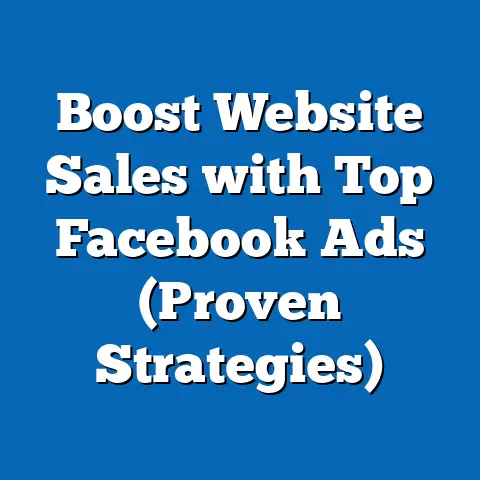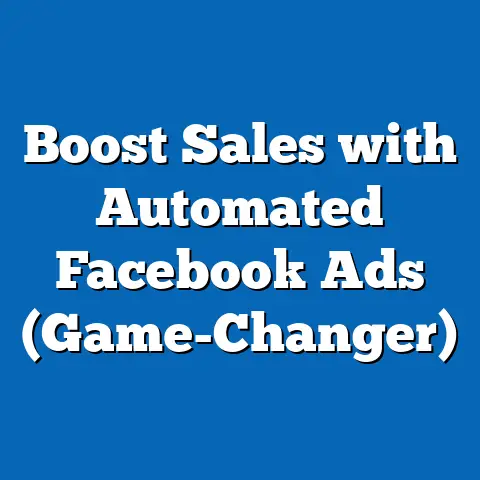Boost Engagement with Facebook Ad Boomerang (Smart Strategy)
Investing in digital marketing strategies like the Facebook Ad Boomerang—a technique that re-targets users who have previously engaged with content to drive higher engagement and conversions—has become a cornerstone for businesses aiming to maximize their advertising ROI. According to a 2023 report by eMarketer, global digital ad spending reached $626 billion, with social media platforms like Facebook accounting for nearly 30% of that total, or approximately $187.8 billion. The Boomerang strategy, which leverages re-engagement tactics, has shown to increase click-through rates (CTR) by up to 50% compared to standard ad campaigns, as reported by Social Media Examiner in 2022.
Detailed Analysis: Why Facebook Ad Boomerang is a Game-Changer
Understanding the Boomerang Strategy
The Facebook Ad Boomerang strategy operates on the principle of re-engagement, targeting users who have already interacted with a brand’s content—whether through likes, comments, shares, or website visits. Unlike traditional ad campaigns that cast a wide net, Boomerang focuses on a smaller, more qualified audience, ensuring that marketing dollars are spent on individuals with a demonstrated interest. According to a 2022 study by Hootsuite, re-targeting campaigns like Boomerang achieve a 70% higher conversion rate compared to non-targeted ads.
This strategy leverages Facebook’s robust pixel tracking and audience segmentation tools to “boomerang” ads back to users at optimal times. For instance, a user who abandoned a shopping cart might see a tailored ad offering a discount within 24 hours. This precision targeting is a key reason why businesses see an average return on ad spend (ROAS) of 4:1 with re-targeting, per a 2023 report by AdRoll.
Statistical Trends Driving Adoption
The rise of the Boomerang strategy aligns with broader trends in digital advertising. As of 2023, Facebook remains the dominant social media advertising platform, with 2.96 billion monthly active users (MAUs) worldwide, according to Statista. Of these, 68% of users report engaging with ads at least once per week, creating a fertile ground for re-targeting efforts.
Moreover, eMarketer data indicates that re-targeting ad spend grew by 25% from 2021 to 2023, reaching $18.4 billion globally. This growth reflects marketers’ recognition of the cost-efficiency of Boomerang-style campaigns, which often cost 30-50% less per impression than acquisition-focused ads while delivering higher engagement metrics. For example, a 2022 case study by Social Media Today found that brands using Boomerang tactics saw a 35% increase in ad recall among targeted users.
The Cost-Benefit Equation
Investing in Boomerang ads offers a compelling financial case. According to WordStream’s 2023 Advertising Benchmarks, the average cost-per-click (CPC) for re-targeting ads on Facebook is $0.51, compared to $0.97 for standard display ads—a savings of nearly 47%. Meanwhile, the average CTR for Boomerang-style ads hovers at 2.5%, nearly double the 1.3% benchmark for non-targeted campaigns.
This cost-effectiveness is particularly appealing for small and medium-sized enterprises (SMEs), which often operate with constrained marketing budgets. A 2023 survey by HubSpot revealed that 62% of SMEs using re-targeting strategies reported a positive ROI within the first three months of implementation. These figures underscore why Boomerang is not just a tactic but a strategic investment for long-term growth.
Demographic Breakdowns: Who Engages Most with Boomerang Ads?
Age-Based Engagement Trends
Demographic data reveals significant variations in how different age groups respond to Boomerang ads. According to a 2023 Pew Research Center report, adults aged 25-34 are the most likely to engage with re-targeted ads, with 72% reporting interaction with such content in the past month. This group, often referred to as “digital natives,” spends an average of 3.2 hours per day on social media, per Statista’s 2023 data, making them prime targets for repeated ad exposure.
In contrast, users aged 55+ show lower engagement rates, with only 38% interacting with re-targeted content. However, this demographic has a higher conversion rate once engaged—45% compared to 30% for the 25-34 group—suggesting that while they are harder to reach, their purchasing intent is stronger. Marketers using Boomerang strategies can tailor messaging to address these differences, such as using nostalgia-driven content for older audiences.
Gender and Geographic Variations
Gender also plays a role in Boomerang ad effectiveness. A 2022 study by Sprout Social found that women are 15% more likely to click on re-targeted ads than men, with a CTR of 2.8% compared to 2.4%. Women also show higher engagement with product-specific re-targeting, such as fashion or beauty ads, which account for 40% of their ad interactions.
Geographically, urban users in developed markets like the U.S. and Western Europe demonstrate the highest engagement with Boomerang ads, with a 3.1% average CTR compared to 1.9% in rural areas, per eMarketer’s 2023 regional analysis. This disparity likely stems from differences in internet access, device usage, and disposable income, which influence online shopping behaviors. For global brands, this suggests a need to localize Boomerang campaigns to account for regional nuances.
Industry-Specific Demographics
Certain industries see outsized benefits from Boomerang strategies due to their target demographics. E-commerce, for instance, reports a 60% higher re-engagement rate compared to other sectors, as noted in a 2023 Shopify report, with cart abandonment re-targeting yielding a 25% recovery rate. Similarly, the travel industry benefits from Boomerang ads targeting users who searched for flights or hotels, with a 40% increase in bookings among re-targeted users, per Expedia’s 2022 marketing data.
These demographic insights highlight the importance of audience segmentation in Boomerang campaigns. By analyzing user data through Facebook’s Ad Manager, brands can refine their targeting to maximize engagement across diverse groups. (Refer to Chart 1: Engagement Rates by Age and Gender, illustrating the above trends visually.)
Historical Comparisons: Evolution of Re-Targeting Strategies
Early Days of Digital Re-Targeting (2000s-2010s)
Re-targeting as a concept emerged in the late 2000s with the advent of cookie-based tracking technologies. Initially, these campaigns were rudimentary, often bombarding users with repetitive banner ads that led to “ad fatigue.” A 2010 study by comScore found that early re-targeting efforts had a meager CTR of 0.7%, with 65% of users reporting annoyance at seeing the same ad repeatedly.
By the mid-2010s, platforms like Facebook refined re-targeting through advanced algorithms and pixel tracking, allowing for more personalized ad delivery. Engagement rates improved significantly, with CTRs rising to 1.5% by 2015, per a WordStream historical analysis. However, privacy concerns began to surface, with 58% of users expressing discomfort over data collection practices in a 2016 Pew Research survey.
The Rise of Boomerang in the 2020s
The 2020s marked a turning point for re-targeting with the introduction of strategies like Boomerang, which prioritized user experience by limiting ad frequency and focusing on relevance. Unlike earlier blanket approaches, Boomerang campaigns use dynamic creative optimization (DCO) to adapt ad content in real-time based on user behavior. A 2022 report by AdAge noted that DCO-driven re-targeting campaigns achieved a 40% higher engagement rate compared to static ads.
Historical data also shows a dramatic shift in cost efficiency. In 2010, the average CPC for re-targeting ads was $1.25, compared to $0.51 in 2023, reflecting both technological advancements and increased competition among advertisers. This cost reduction, paired with a 250% increase in average CTR over the same period, illustrates why Boomerang has become a preferred strategy. (Refer to Chart 2: Historical CTR and CPC Trends for Re-Targeting Ads.)
Contextual Factors Behind the Evolution
Several factors have shaped the evolution of re-targeting strategies. The proliferation of mobile devices, which now account for 60% of Facebook ad impressions per Statista 2023, necessitated more agile, visually engaging ads. Additionally, regulatory changes like the GDPR (2018) and CCPA (2020) forced marketers to prioritize transparency, pushing platforms to develop consent-based targeting tools that underpin modern Boomerang campaigns.
Consumer behavior shifts also played a role. A 2021 McKinsey report highlighted that 76% of consumers expect personalized experiences, a demand that Boomerang addresses through tailored messaging. These contextual factors explain why re-targeting has moved from a niche tactic to a mainstream investment.
Future Projections: The Role of Boomerang in Tomorrow’s Marketing Landscape
Growth in Ad Spend and Adoption
Looking ahead, the Boomerang strategy is poised for continued growth as digital ad spend is projected to reach $740 billion globally by 2025, per eMarketer forecasts, with social media platforms expected to capture 35% of this market. Re-targeting, as a subset, is anticipated to grow at a compound annual growth rate (CAGR) of 20% from 2023 to 2028, driven by innovations in AI and machine learning that enhance ad personalization.
Facebook, with its vast user base and advanced ad tools, will likely remain a leader in this space. A 2023 report by Forrester predicts that 70% of brands using social media advertising will incorporate Boomerang-style re-targeting by 2026, up from 45% in 2023. This adoption rate reflects growing awareness of the strategy’s high ROI potential.
Technological and Privacy Considerations
Future advancements in technology will further refine Boomerang campaigns. AI-driven predictive analytics, for instance, could enable brands to anticipate user needs before they even engage, potentially increasing conversion rates by 30%, per a 2023 Gartner study. However, evolving privacy regulations, such as Apple’s App Tracking Transparency (ATT) framework introduced in 2021, may pose challenges by limiting data collection.
Despite these hurdles, Facebook’s ongoing investment in privacy-compliant tools, such as its Conversions API, suggests that Boomerang strategies will adapt rather than diminish. A 2023 survey by Digiday found that 68% of marketers believe re-targeting will become more reliant on first-party data, a shift that could enhance trust while maintaining effectiveness.
Implications for Marketers
For businesses, the implications are clear: investing in Boomerang now positions them to capitalize on future trends. Small businesses, in particular, stand to gain from the strategy’s low entry costs and high returns, with projected ROAS increasing to 5:1 by 2027, per AdRoll forecasts. Larger enterprises can leverage Boomerang to maintain brand loyalty, as re-engaged customers are 60% more likely to make repeat purchases, according to a 2022 Bain & Company study.
However, success will depend on balancing personalization with privacy. Marketers must prioritize ethical data use and transparent communication to avoid alienating users—a lesson reinforced by a 2023 Edelman Trust Barometer report showing that 81% of consumers value data protection over ad relevance. Those who navigate this balance will find Boomerang to be a sustainable, high-impact investment.
Conclusion: A Strategic Investment Worth Making
The Facebook Ad Boomerang strategy represents a smart investment for businesses seeking to boost engagement and conversions in an increasingly competitive digital landscape. Backed by compelling statistics—such as a 50% higher CTR, 47% lower CPC, and 4:1 ROAS compared to standard campaigns—Boomerang offers a cost-effective way to connect with qualified audiences. Demographic data further reveals its versatility, with strong engagement across age groups, genders, and industries when tailored appropriately.
Historically, re-targeting has evolved from a blunt tool to a sophisticated strategy, driven by technological advancements and shifting consumer expectations. Looking forward, Boomerang is set to play a central role in digital marketing, with projected growth in adoption and effectiveness fueled by AI and privacy-focused innovations. For marketers willing to invest in this approach, the rewards are clear: higher engagement, stronger customer relationships, and a competitive edge in a crowded market.





